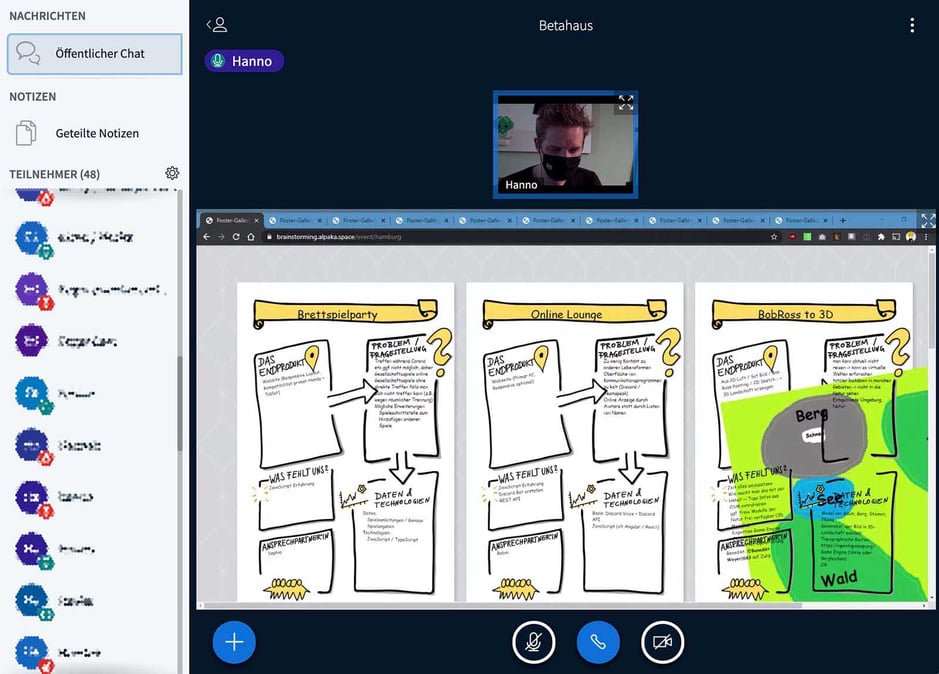No parents, no teachers, a place of your own that you share with other young people where everyone works together on very individual projects - that is Jugend hackt. The program actually takes young people out of their usual environment very intentionally.
The events take place from Friday to Sunday, and even though they end with a public presentation of apps and other prototypes, one thing is clear: much more important than any lines of code written are the new friendships and the experience of having worked on something together, on equal footing.
The encounters and the spatial proximity are therefore a very important part of Jugend hackt's DNA. The program has not offered online courses until now, but the coronavirus pandemic posed a very special challenge for the team: can the weekend format be transferred online at all?
Now, after four events that took place fully online, we can say: yes, but... Not everything works out in the same way and the focus needs to be different. Three realizations have come out of Jugend hackt in recent months:
Realization 1: The tools absolutely need to work. By now we all know the frustration of failed video conferences and conference calls. What works with five people can quickly become a test of patience with 30 or more participants. This means: test everything carefully in advance, and then test once again. Before the start of the actual event, definitely schedule a time when each participant can test if things are working, and if not, solve the problem with individual support.
Traditional on-site events also have technical problems, but in those cases everyone is in one place anyway and can keep talking to each other until the problems are resolved. The schedule suffers, but nobody is lost.
If, in contrast, a participant is cut off from the communication, the feeling of community is gone right away. Instead, there is a tense search for the error, and it gets stressful. There is the risk that one of the young people gives up and stops participating.
Realization 2 is related to this: Online mentors are needed to accompany the young people throughout the event. In regular Jugend hackt events, there is a ratio of one to three, meaning that one adult mentors about three young people.
Online, a ratio of 2 or even 1.5 to 1 has proven to be sensible: in the last Jugend hackt event in September, there were 20 mentors for 30 young people. One of the reasons was already mentioned above: it is much harder not to lose anyone online in the course of the weekend.
During on-site events, all you have to do is take a look in the room: everyone's there, everyone's busy. If one of the young people is dissatisfied or demotivated, it is quickly noticeable and the mentors can address the problems in a spontaneous one-on-one conversation.
This is not possible during online events. If one of the young people is missing, it is unclear whether he/she is working on his/her own project in depth or is taking a break - or whether he/she gave up without any (identified) feedback.
Therefore, in online Jugend hackt events, an adult has gone through all the virtual rooms almost constantly, counting the participants, and called the participants in case of doubt to see how they are doing. Obviously, any of the young people can choose to leave anytime, but if this happens due to frustration about technical problems or unsolved communication hurdles, it is a pity for everyone.
Realization 3: To get the real Jugend hackt flair takes more than just a video call and documents that can be edited collaboratively. There are many details to on-site events, including the pre-project brainstorming method refined over the years as well as aspects such as the right decoration.
Normally, the young people develop project ideas on Friday evening, write them on big posters and present them in one minute. The posters then hang on walls, other young people can comment on them, and by Saturday morning they finally become the basis for the project work.
How can this poster gallery be shown online? Hanno from the organization team of Jugend hackt in Hamburg was not happy with the fact that the young people were supposed to click through a series of plain text files and programmed a special tool for Jugend hackt that shows the project proposals as digital posters that you can browse through in the browser.

Jugend hackt digital Poster gallery (CC-BY 4.0 Jugend hackt, Foto: Hanno Sternberg)
Another of Hanno's ideas: virtual applause for the live stream in the end of the event where all the young people present their projects. He programmed a toolbar with different emojis for this, which is shown under the public video. Clicking on an "applause" emoji generates an image that is visible both in the stream and in the video call with the young people. This way, it was less weird to present just for the webcam, without any real audience.
In the live stream, you can see a few goodies that all participants receive by mail in advance: the limited stickers available in each event and this year's bonus, a face mask with the Jugend hackt logo. All the mentors also received a specially designed t-shirt. All this is not just merchandise. These are small mementos that will remind all the participants of these weekends for a long time.
Next digital event will be from 27.-29. November!


Do you have any questions or comments? Then please leave us a comment.